Analysis of McDonald's 'On Your Way, All Night Open' Image
VerifiedAdded on 2023/05/30
|6
|1126
|387
AI Summary
This analysis explores the signifiers and signifieds of McDonald's 'On Your Way, All Night Open' image, as well as its denotations and connotations. It also identifies a wider cultural message or theme that can be identified at the level of myth.
Contribute Materials
Your contribution can guide someone’s learning journey. Share your
documents today.
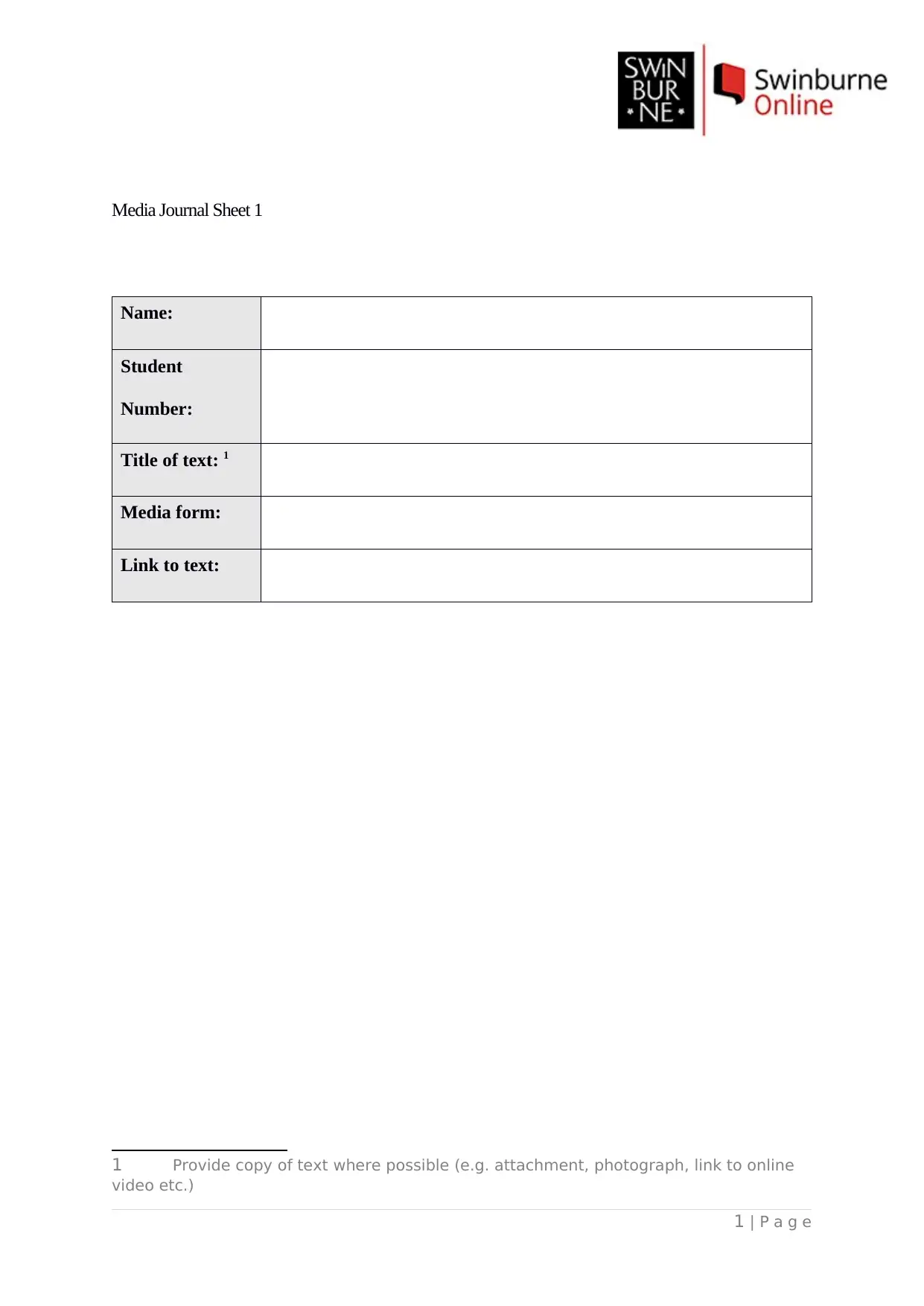
Media Journal Sheet 1
Name:
Student
Number:
Title of text: 1
Media form:
Link to text:
1 Provide copy of text where possible (e.g. attachment, photograph, link to online
video etc.)
1 | P a g e
Name:
Student
Number:
Title of text: 1
Media form:
Link to text:
1 Provide copy of text where possible (e.g. attachment, photograph, link to online
video etc.)
1 | P a g e
Secure Best Marks with AI Grader
Need help grading? Try our AI Grader for instant feedback on your assignments.
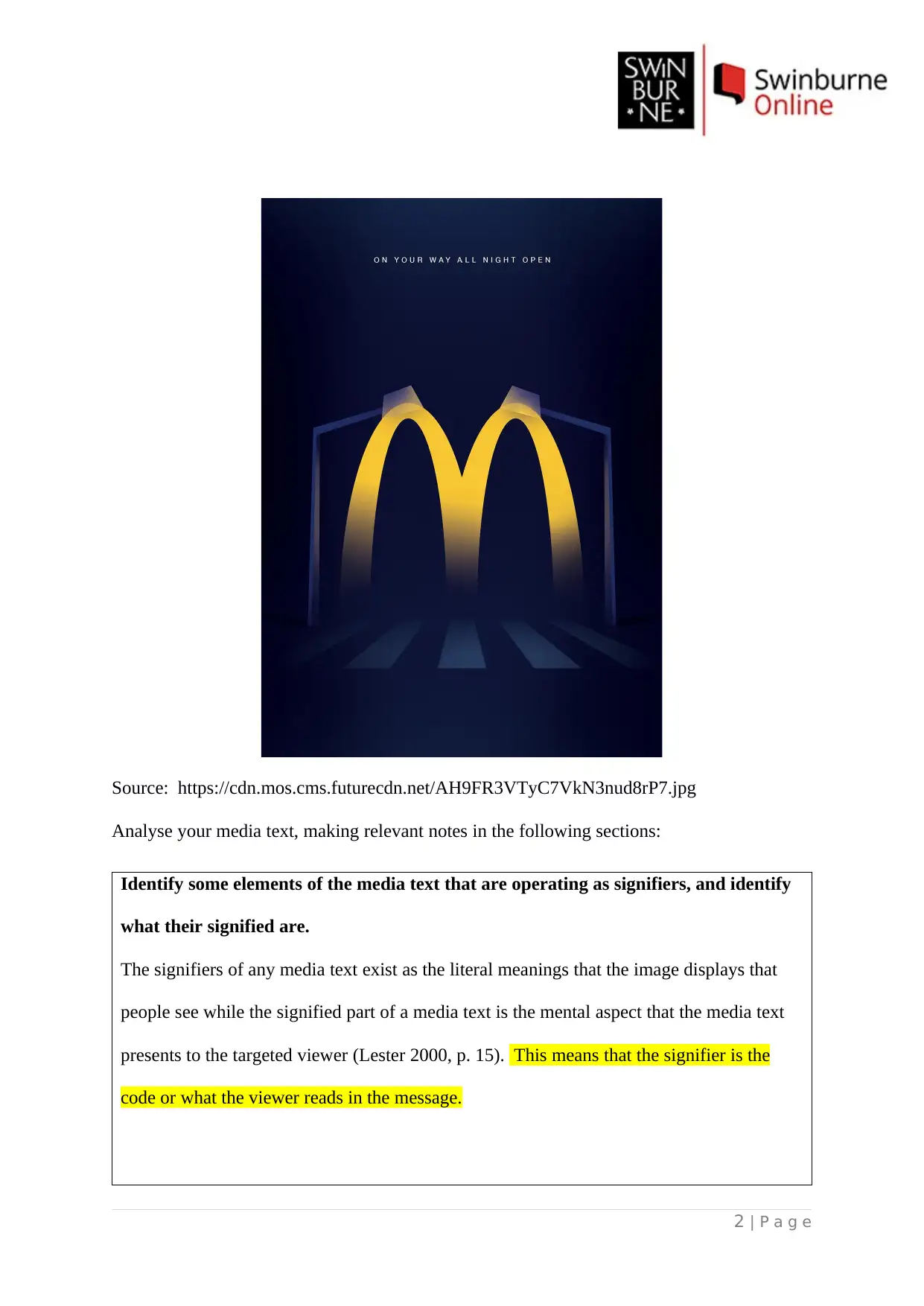
Source: https://cdn.mos.cms.futurecdn.net/AH9FR3VTyC7VkN3nud8rP7.jpg
Analyse your media text, making relevant notes in the following sections:
Identify some elements of the media text that are operating as signifiers, and identify
what their signified are.
The signifiers of any media text exist as the literal meanings that the image displays that
people see while the signified part of a media text is the mental aspect that the media text
presents to the targeted viewer (Lester 2000, p. 15). This means that the signifier is the
code or what the viewer reads in the message.
2 | P a g e
Analyse your media text, making relevant notes in the following sections:
Identify some elements of the media text that are operating as signifiers, and identify
what their signified are.
The signifiers of any media text exist as the literal meanings that the image displays that
people see while the signified part of a media text is the mental aspect that the media text
presents to the targeted viewer (Lester 2000, p. 15). This means that the signifier is the
code or what the viewer reads in the message.
2 | P a g e
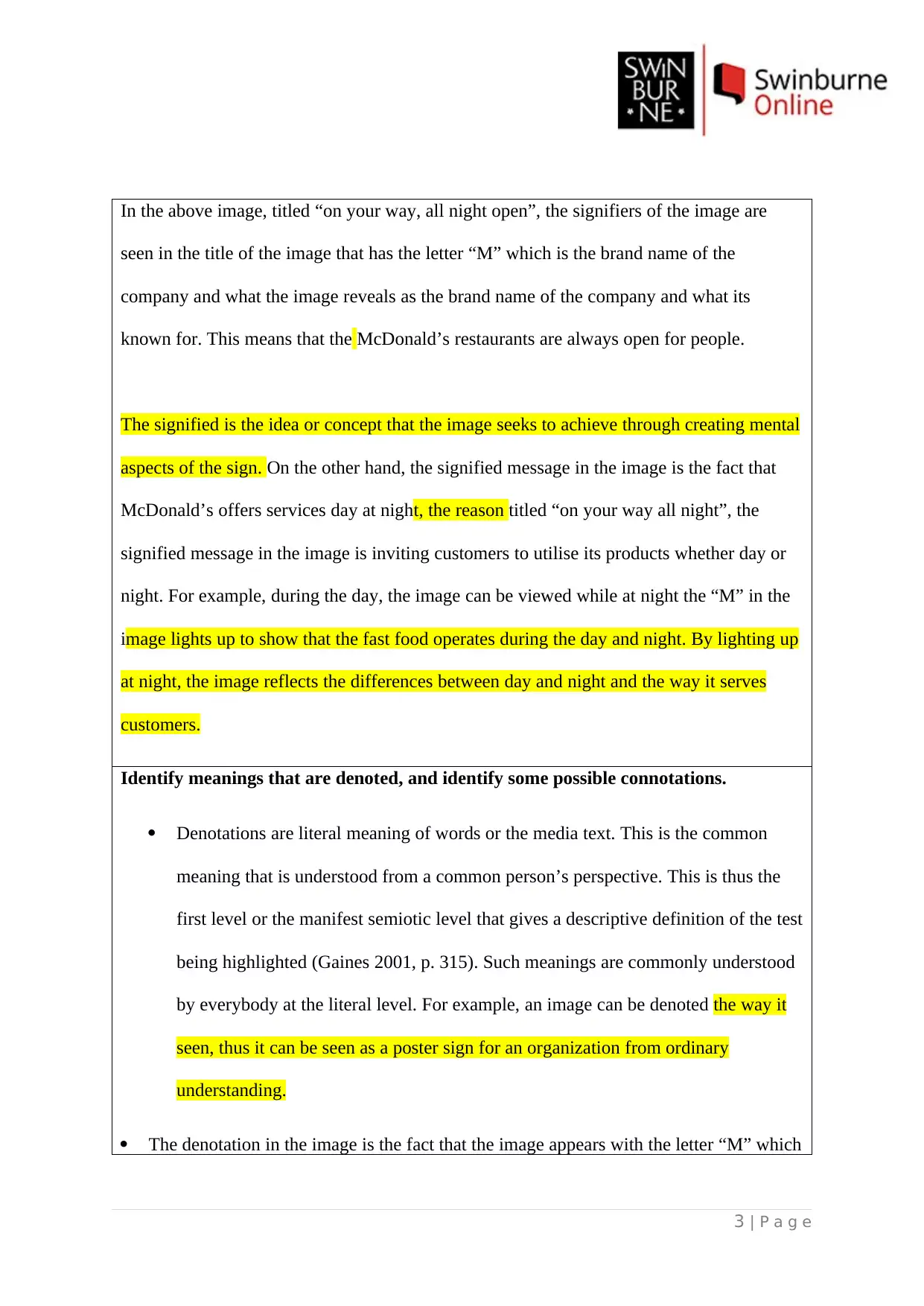
In the above image, titled “on your way, all night open”, the signifiers of the image are
seen in the title of the image that has the letter “M” which is the brand name of the
company and what the image reveals as the brand name of the company and what its
known for. This means that the McDonald’s restaurants are always open for people.
The signified is the idea or concept that the image seeks to achieve through creating mental
aspects of the sign. On the other hand, the signified message in the image is the fact that
McDonald’s offers services day at night, the reason titled “on your way all night”, the
signified message in the image is inviting customers to utilise its products whether day or
night. For example, during the day, the image can be viewed while at night the “M” in the
image lights up to show that the fast food operates during the day and night. By lighting up
at night, the image reflects the differences between day and night and the way it serves
customers.
Identify meanings that are denoted, and identify some possible connotations.
Denotations are literal meaning of words or the media text. This is the common
meaning that is understood from a common person’s perspective. This is thus the
first level or the manifest semiotic level that gives a descriptive definition of the test
being highlighted (Gaines 2001, p. 315). Such meanings are commonly understood
by everybody at the literal level. For example, an image can be denoted the way it
seen, thus it can be seen as a poster sign for an organization from ordinary
understanding.
The denotation in the image is the fact that the image appears with the letter “M” which
3 | P a g e
seen in the title of the image that has the letter “M” which is the brand name of the
company and what the image reveals as the brand name of the company and what its
known for. This means that the McDonald’s restaurants are always open for people.
The signified is the idea or concept that the image seeks to achieve through creating mental
aspects of the sign. On the other hand, the signified message in the image is the fact that
McDonald’s offers services day at night, the reason titled “on your way all night”, the
signified message in the image is inviting customers to utilise its products whether day or
night. For example, during the day, the image can be viewed while at night the “M” in the
image lights up to show that the fast food operates during the day and night. By lighting up
at night, the image reflects the differences between day and night and the way it serves
customers.
Identify meanings that are denoted, and identify some possible connotations.
Denotations are literal meaning of words or the media text. This is the common
meaning that is understood from a common person’s perspective. This is thus the
first level or the manifest semiotic level that gives a descriptive definition of the test
being highlighted (Gaines 2001, p. 315). Such meanings are commonly understood
by everybody at the literal level. For example, an image can be denoted the way it
seen, thus it can be seen as a poster sign for an organization from ordinary
understanding.
The denotation in the image is the fact that the image appears with the letter “M” which
3 | P a g e
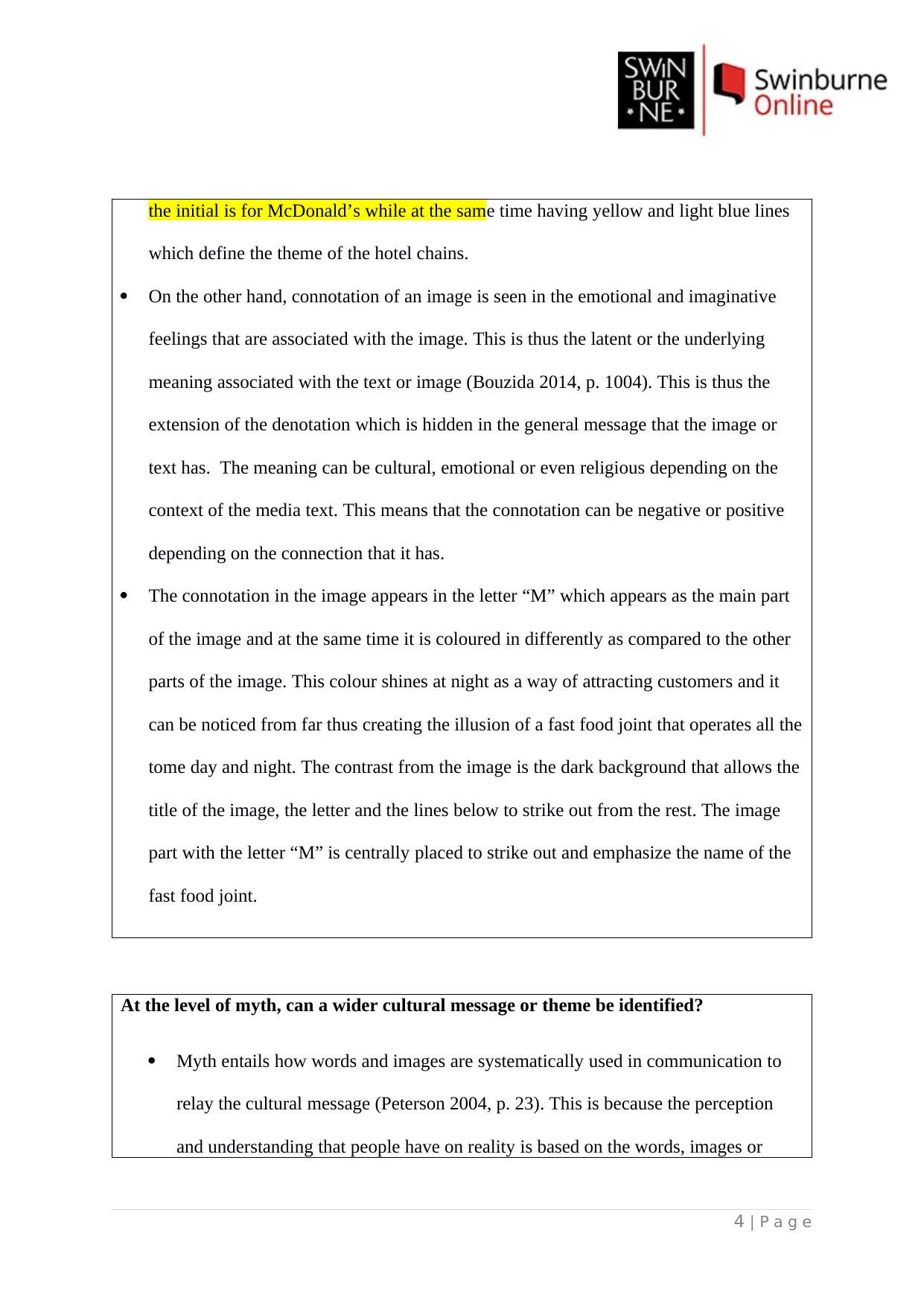
the initial is for McDonald’s while at the same time having yellow and light blue lines
which define the theme of the hotel chains.
On the other hand, connotation of an image is seen in the emotional and imaginative
feelings that are associated with the image. This is thus the latent or the underlying
meaning associated with the text or image (Bouzida 2014, p. 1004). This is thus the
extension of the denotation which is hidden in the general message that the image or
text has. The meaning can be cultural, emotional or even religious depending on the
context of the media text. This means that the connotation can be negative or positive
depending on the connection that it has.
The connotation in the image appears in the letter “M” which appears as the main part
of the image and at the same time it is coloured in differently as compared to the other
parts of the image. This colour shines at night as a way of attracting customers and it
can be noticed from far thus creating the illusion of a fast food joint that operates all the
tome day and night. The contrast from the image is the dark background that allows the
title of the image, the letter and the lines below to strike out from the rest. The image
part with the letter “M” is centrally placed to strike out and emphasize the name of the
fast food joint.
At the level of myth, can a wider cultural message or theme be identified?
Myth entails how words and images are systematically used in communication to
relay the cultural message (Peterson 2004, p. 23). This is because the perception
and understanding that people have on reality is based on the words, images or
4 | P a g e
which define the theme of the hotel chains.
On the other hand, connotation of an image is seen in the emotional and imaginative
feelings that are associated with the image. This is thus the latent or the underlying
meaning associated with the text or image (Bouzida 2014, p. 1004). This is thus the
extension of the denotation which is hidden in the general message that the image or
text has. The meaning can be cultural, emotional or even religious depending on the
context of the media text. This means that the connotation can be negative or positive
depending on the connection that it has.
The connotation in the image appears in the letter “M” which appears as the main part
of the image and at the same time it is coloured in differently as compared to the other
parts of the image. This colour shines at night as a way of attracting customers and it
can be noticed from far thus creating the illusion of a fast food joint that operates all the
tome day and night. The contrast from the image is the dark background that allows the
title of the image, the letter and the lines below to strike out from the rest. The image
part with the letter “M” is centrally placed to strike out and emphasize the name of the
fast food joint.
At the level of myth, can a wider cultural message or theme be identified?
Myth entails how words and images are systematically used in communication to
relay the cultural message (Peterson 2004, p. 23). This is because the perception
and understanding that people have on reality is based on the words, images or
4 | P a g e
Paraphrase This Document
Need a fresh take? Get an instant paraphrase of this document with our AI Paraphraser

other signs that exist in the society that they live in.
The image is a mythical connection between darkness and daylight. From the image,
the background is dark while the title and the main elements if the image are bright
colour. This means that the restaurant is striking out whether during the day or night. At
night the brighter part of the image shines thus making it visible from very far. This
indicates the ability of the restaurant to even work at night all the time that is why it is
titled all the way on your way all night. Therefore the wider cultural message is that
McDonald’s serves its customers beyond day time.
Additional Notes/Observations:
McDonald’s changed its image recently as a marketing and advertising strategy that
places the fast food chain as one of the best joints that serves customers 24 hours.
Even though the image has very few colours and designs in it, the simplicity itself
defines the mode of operation that the fast food uses where customers come in and
live as soon as they are done. That is to signify the nature of a fast food and not a
restaurant.
5 | P a g e
The image is a mythical connection between darkness and daylight. From the image,
the background is dark while the title and the main elements if the image are bright
colour. This means that the restaurant is striking out whether during the day or night. At
night the brighter part of the image shines thus making it visible from very far. This
indicates the ability of the restaurant to even work at night all the time that is why it is
titled all the way on your way all night. Therefore the wider cultural message is that
McDonald’s serves its customers beyond day time.
Additional Notes/Observations:
McDonald’s changed its image recently as a marketing and advertising strategy that
places the fast food chain as one of the best joints that serves customers 24 hours.
Even though the image has very few colours and designs in it, the simplicity itself
defines the mode of operation that the fast food uses where customers come in and
live as soon as they are done. That is to signify the nature of a fast food and not a
restaurant.
5 | P a g e
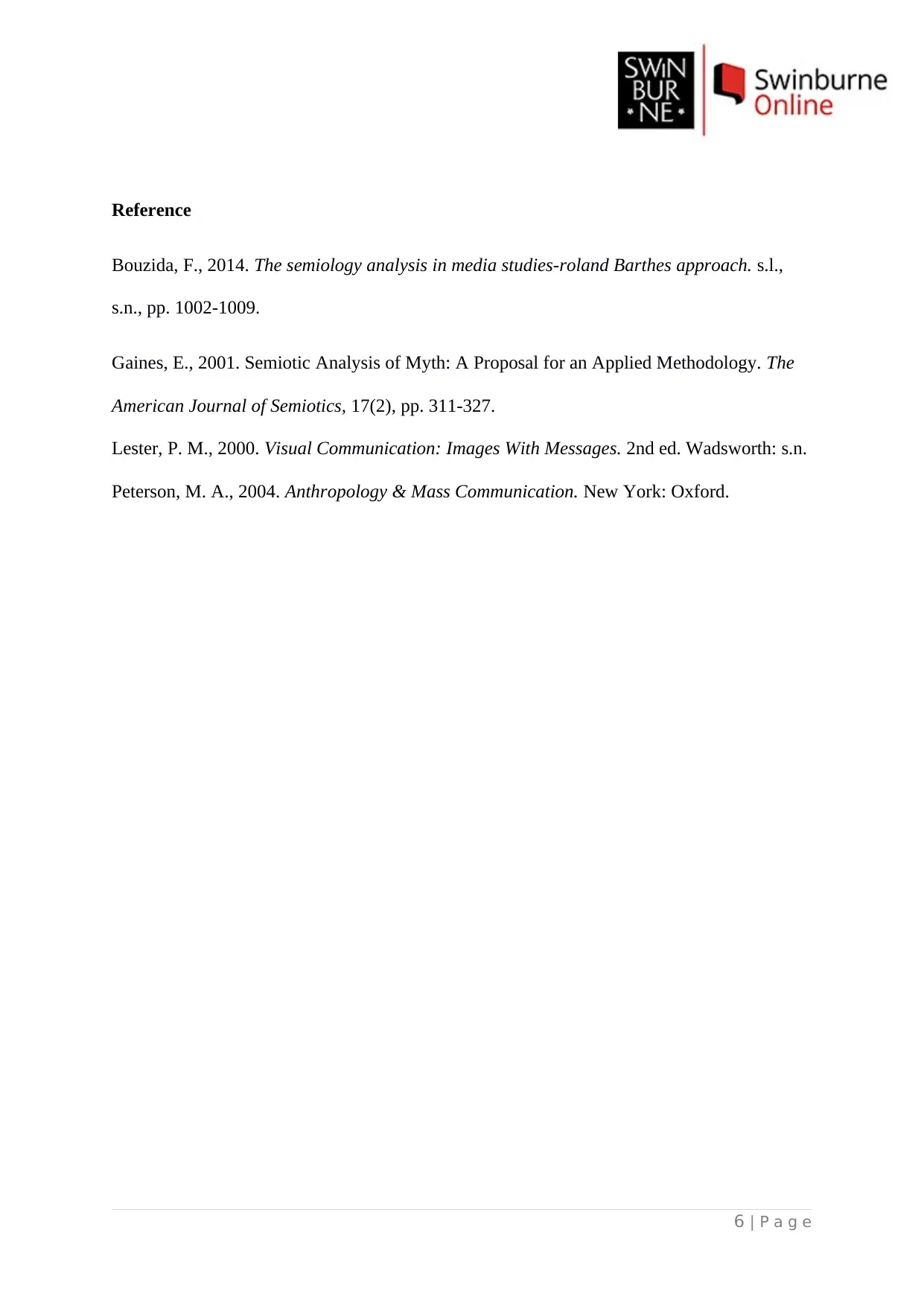
Reference
Bouzida, F., 2014. The semiology analysis in media studies-roland Barthes approach. s.l.,
s.n., pp. 1002-1009.
Gaines, E., 2001. Semiotic Analysis of Myth: A Proposal for an Applied Methodology. The
American Journal of Semiotics, 17(2), pp. 311-327.
Lester, P. M., 2000. Visual Communication: Images With Messages. 2nd ed. Wadsworth: s.n.
Peterson, M. A., 2004. Anthropology & Mass Communication. New York: Oxford.
6 | P a g e
Bouzida, F., 2014. The semiology analysis in media studies-roland Barthes approach. s.l.,
s.n., pp. 1002-1009.
Gaines, E., 2001. Semiotic Analysis of Myth: A Proposal for an Applied Methodology. The
American Journal of Semiotics, 17(2), pp. 311-327.
Lester, P. M., 2000. Visual Communication: Images With Messages. 2nd ed. Wadsworth: s.n.
Peterson, M. A., 2004. Anthropology & Mass Communication. New York: Oxford.
6 | P a g e
1 out of 6
![[object Object]](/_next/static/media/star-bottom.7253800d.svg)